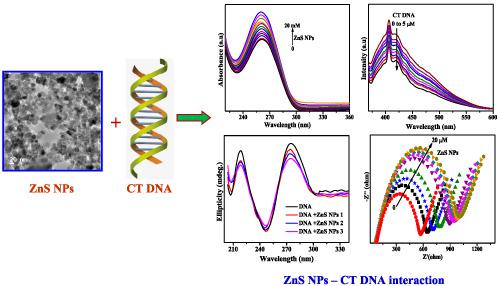当前位置:
X-MOL 学术
›
Luminescence
›
论文详情
Our official English website, www.x-mol.net, welcomes your
feedback! (Note: you will need to create a separate account there.)
Molecular interaction studies of zinc sulphide nanoparticles with DNA and its consequence: a multitechnique approach
Luminescence ( IF 3.2 ) Pub Date : 2020-07-08 , DOI: 10.1002/bio.3912 Mallappa Mahanthappa 1, 2, 3 , Mohammed Azharuddin Savanur 4, 5 , Shivaraj Yellappa 1
Luminescence ( IF 3.2 ) Pub Date : 2020-07-08 , DOI: 10.1002/bio.3912 Mallappa Mahanthappa 1, 2, 3 , Mohammed Azharuddin Savanur 4, 5 , Shivaraj Yellappa 1
Affiliation

|
Molecular interaction studies between nanoparticles (NPs) and biomolecules are of great importance in the field of nanomedicine as they affect many physiological processes. Therefore, the interaction of zinc sulphide nanoparticles (ZnS NPs) with calf thymus deoxyribonucleic acid (CT DNA) and its significance was analyzed using ultraviolet (UV)–visible light, fluorescence, circular dichroism (CD), zeta potential, viscometry, electrochemical, and polymerase chain reaction methods. Fluorescence quenching analysis revealed that the fluorescence of ZnS NPs was quenched using CT DNA through a static quenching mechanism. The negative values of thermodynamic parameters (ΔG, ΔH, and ΔS) showed that the binding process was spontaneous, exothermic, and van der Waals or hydrogen bonding plays an important role in the interaction of ZnS NPs with CT DNA. Thermal melting (Tm) studies indicated a decrease in the Tm of CT DNA, suggesting the destabilization of CT DNA upon interaction with ZnS NPs. In addition, the results obtained from competitive binding, zeta potential, CD, and viscometry measurements showed that the interaction of ZnS NPs with CT DNA is through groove binding. Electrochemical analysis further confirmed the observed results from various spectroscopic and other related studies, in which decrease in the redox peak current along with changes in peak potential (CV) and increase in the electrical resistance (EIS) indicated the interaction between ZnS NPs and CT DNA. Furthermore, PCR analysis using DNA polymerase revealed the potential of ZnS NPs to inhibit DNA replication in vitro. ZnS NP–CT DNA interaction studies can be explored to define new horizons in biomedical applications of ZnS NPs.
中文翻译:

硫化锌纳米粒子与DNA的分子相互作用研究及其结果:一种多技术方法
纳米颗粒(NPs)与生物分子之间的分子相互作用研究在纳米医学领域具有重要意义,因为它们影响许多生理过程。因此,使用紫外线(UV)-可见光,荧光,圆二色性(CD),ζ电位,粘度计,电化学,和聚合酶链反应方法。荧光猝灭分析显示,ZnS NPs的荧光通过静态猝灭机制使用CT DNA猝灭。热力学参数的负值(ΔG,ΔH和ΔS)表明结合过程是自发的,放热的,范德华或氢键在ZnS NP与CT DNA的相互作用中起重要作用。热熔(T m)研究表明T m降低CT DNA的突变,提示与ZnS NPs相互作用时CT DNA不稳定。此外,从竞争结合,ζ电位,CD和粘度测量结果获得的结果表明,ZnS NP与CT DNA的相互作用是通过凹槽结合。电化学分析进一步证实了各种光谱学和其他相关研究的观察结果,其中氧化还原峰值电流的减少以及峰值电位(CV)的变化和电阻(EIS)的增加表明了ZnS NP与CT DNA之间的相互作用。此外,使用DNA聚合酶的PCR分析显示了ZnS NP在体外抑制DNA复制的潜力。可以探索ZnS NP–CT DNA相互作用的研究,以定义ZnS NPs在生物医学应用中的新视野。
更新日期:2020-07-08
中文翻译:

硫化锌纳米粒子与DNA的分子相互作用研究及其结果:一种多技术方法
纳米颗粒(NPs)与生物分子之间的分子相互作用研究在纳米医学领域具有重要意义,因为它们影响许多生理过程。因此,使用紫外线(UV)-可见光,荧光,圆二色性(CD),ζ电位,粘度计,电化学,和聚合酶链反应方法。荧光猝灭分析显示,ZnS NPs的荧光通过静态猝灭机制使用CT DNA猝灭。热力学参数的负值(ΔG,ΔH和ΔS)表明结合过程是自发的,放热的,范德华或氢键在ZnS NP与CT DNA的相互作用中起重要作用。热熔(T m)研究表明T m降低CT DNA的突变,提示与ZnS NPs相互作用时CT DNA不稳定。此外,从竞争结合,ζ电位,CD和粘度测量结果获得的结果表明,ZnS NP与CT DNA的相互作用是通过凹槽结合。电化学分析进一步证实了各种光谱学和其他相关研究的观察结果,其中氧化还原峰值电流的减少以及峰值电位(CV)的变化和电阻(EIS)的增加表明了ZnS NP与CT DNA之间的相互作用。此外,使用DNA聚合酶的PCR分析显示了ZnS NP在体外抑制DNA复制的潜力。可以探索ZnS NP–CT DNA相互作用的研究,以定义ZnS NPs在生物医学应用中的新视野。











































 京公网安备 11010802027423号
京公网安备 11010802027423号